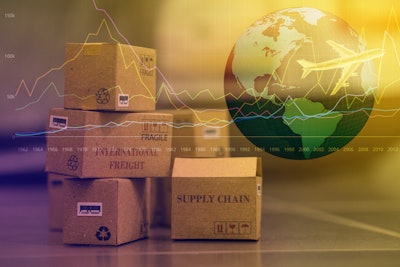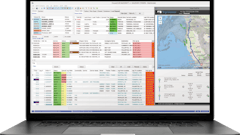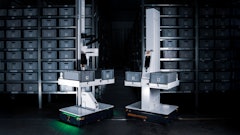
In 2025 and the years to come, upheavals in global trade, brought on by the deteriorating geopolitical climate, will make close collaboration up and down the supply chain critical to resilient, compliant commerce.
The global production system comprises hundreds of millions of companies and billions of transactions each year, and a single multinational corporation can work with tens and even hundreds of thousands of trading partners and dozens of regulators across the world.
That's far too many for supply chain executives and compliance teams to handle manually, so companies will come increasingly to rely on advances in artificial intelligence and networked platforms to manage their products’ value chains. Those advances will enable suppliers, customers and regulators to collaborate across their networks, building trust and facilitating compliance in a dynamic and increasingly complex trade environment.
Artificial intelligence can knit together and analyze vast quantities of public, commercial and proprietary supply chain data, creating a shared source of truth that underpins collaboration among businesses and regulators on compliance, sourcing, procurement and resilience. That shared source of truth will improve the ability for businesses and regulators to analyze and manage risk and enforce policy at scale and will open new opportunities in supply chain insurance and trade finance.
In the years ahead, great power competition between the U.S. and China, a general increase in global conflict, and the desire in the US and other industrialized nations to reshore manufacturing will lead to the further deterioration of trade relations. The U.S.-China trade war will gain in intensity under the new administration, which has threatened to raise tariffs on the top supplier of US goods imports in order to boost domestic manufacturing and bolster critical domestic supply chains.
China’s state-engineered overcapacity across its industrial base is threatening entire national industries and affecting the terms of trade in advanced technologies like electric vehicles and solar panels. Meanwhile, the U.S. has identified Chinese electric vehicle components, drones and drone components, telecommunications equipment, and even the popular video sharing app TikTok as potential national security threats. The U.S. is strictly enforcing a law aimed at eradicating Chinese forced labor from the supply chain, focusing on apparel, seafood, and polysilicon among other priority sectors. Altana’s analysis of supply chain data shows many major U.S. companies across industries have links to forced labor; US companies with complicated value chains may have dozens of companies in their supply chains that are exposed to the Uyghur Forced Labor Prevention Act, comprising thousands of transactions a year. The companies are often unaware of the connection to forced labor, found in multi-tier production relations deep within supply chains.
Tariffs and other policy mechanisms will drive companies – and whole economies – to reorient global sourcing away from China, to increase the resilience and geographic spread of their supply chains. That will encourage the rearrangement of manufacturing locations and transshipment waypoints, boosting trade in the EU, India, Japan, Korea, Mexico and Vietnam.
Companies will also seek to defend their supply chains against natural disaster, exacerbated by climate change, and look to nearshoring and localization to reduce exposure to transportation outages.
Meanwhile, to enforce increasingly complex trade policy, regulators in the US will want to see deep into the value chain to police rules of origin and investigate transshipment.
Beyond China, President Trump threatens to upend close, longstanding, trade partnerships with Canada, Mexico and EU states, by introducing tariffs to press them on non-trade issues such as fentanyl production and Trump’s stated desire for US territorial expansion. The size and complexity of those bilateral trade relationships will cause further upheaval within American companies’ value chains.
Trump’s trade team has yet to offer detail on the precise shape of the tariffs, but in the short-term the uncertainty itself will push companies to diversify their value chains away from China – and back into the US.
All of this will collide with longstanding businesses’ just-in-time manufacturing and inventory practices and regulators caught between their dual missions of trade facilitation and compliance enforcement.
In this business environment, sourcing, logistics and compliance are growing ever more complicated and time-consuming. Importers are being asked to prove the country of origin of their goods and their content, ensure their foreign sales don’t violate export controls, cooperate with regulatory, law enforcement and intelligence investigations, and much more.
Certifications that can prove the lineage of a product and its components will develop into an integral element of the importer value chain. That will demand close collaboration up and down the supply chain, with logistics parties and brokers, and with customs officials, sanctions and trade enforcement agencies, and industry regulators .
Collaboration platforms are emerging to enable easy exchange of product certifications and supporting documentation. By sitting on top of AI-powered value chain maps, these systems will allow automation of the rote work and the ability of humans to collaborate on the most difficult or sensitive areas. The result of such collaboration will be the ability to directly discuss and resolve concerns about a given shipment’s extended value chain, and thus faster clearance at the border. In other words, more efficient and compliant passage at the border, without the current cat-and-mouse dynamics.
Business customers will increasingly expect their suppliers to have a deep understanding of their own supply chains and engage in collaboration to deal with a quickly shifting geopolitical/trade-war landscape. Regulators will require increasingly detailed understandings of the multiple-tiers involved in production of a good – the whole value chain.
Paradoxically, all the uncertainty and upheaval in global trade creates an opportunity for unity and cohesion among its players. To make sense of the endeavor, to smooth it and shape it will demand collective, collaborative action among manufacturers, logistics service providers and regulators. And that will depend on a common source of truth constructed and maintained by artificial intelligence and a dependable, flexible platform to serve as a forum.
















